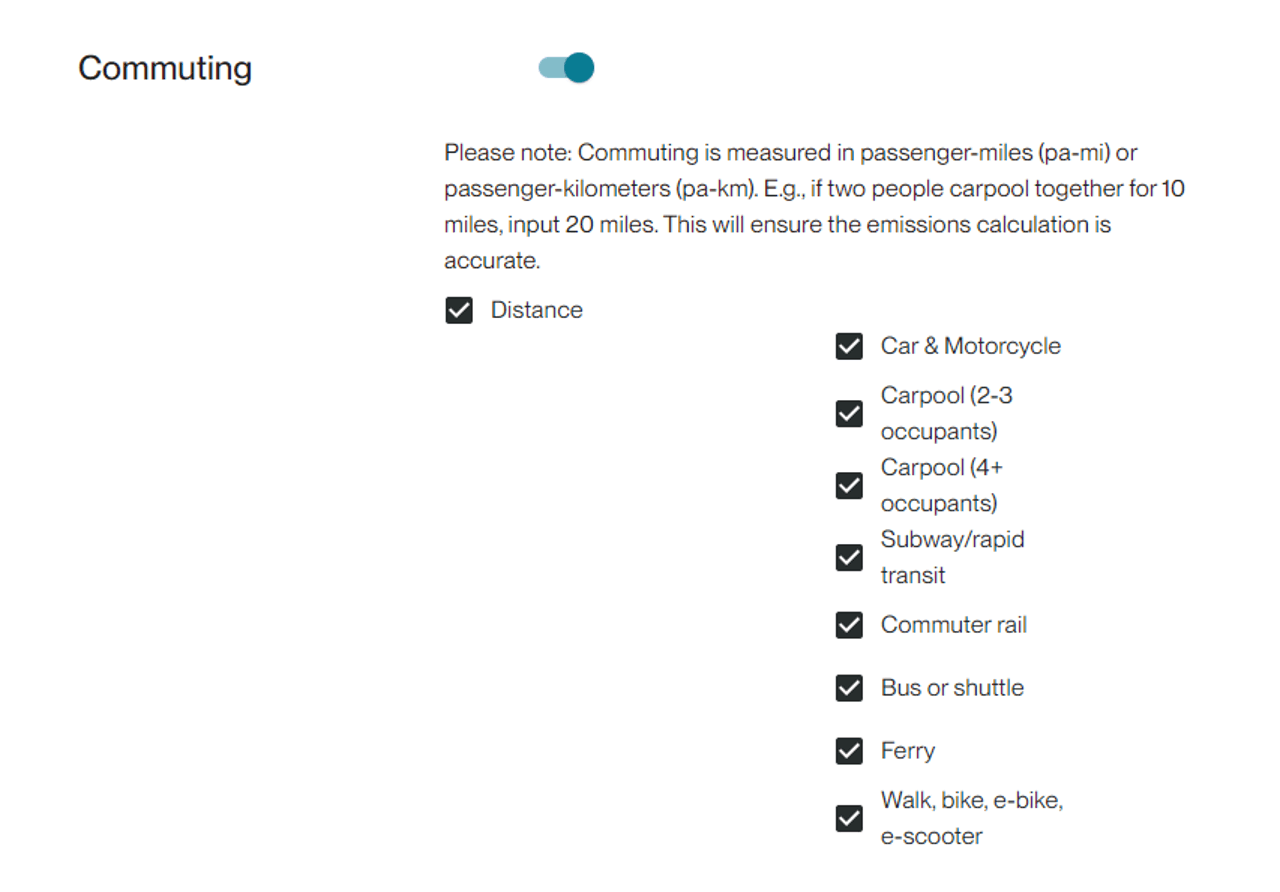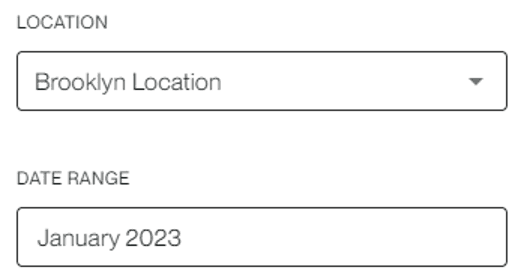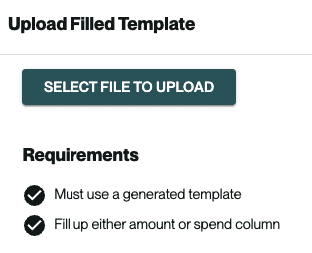Categories
People: Employee commuting
Last updated: February 2023
Table of contents
The employee commuting feature helps track emissions from your employees’ commutes from their homes to their worksites. The calculator supports commuting emissions from road vehicles, subway/rapid transit systems, commuter rail, buses/shuttles, water ferries, and walking/biking. Only commutes in non-company vehicles to a regular worksite should be included in this category. Commutes in company-owned or leased vehicles should be tracked under Vehicles. If the commute is to a non-regular worksite, such as from an employee’s home to a client’s office, it should be tracked as Business Travel.
Workiva Carbon uses the distance-based method to calculate emissions from employee commuting and multiplies emission factors by the distance travelled via different modes. In the case of road vehicles, you may track by fuel use instead of distance. This method is more accurate and recommended if you have fuel use data.
Optionally, you may enter spend for each mode of travel to keep track of total costs, but it won’t be used in the emissions calculation.
In Settings, toggle on the Commuting section in the People category. Track commuting distance by selecting the modes of transportation that are applicable for your company and employees. Commuting is measured in passenger-miles or passenger-kilometers. Eg if two people carpool together for 10 miles, input 20 miles. This will ensure the emissions calculation is accurate.

Manual entry
To record your data manually, click the “+” icon in the top left corner. Recording manually is best if you don’t have a significant amount of commuting to track. Select the desired location and month.

Enter the number of pa-mi (or pa-km) by mode of transportation that your employees at this location use to travel to work. If you would like to track spend, you can input that information in the spend column.
Bulk import via template
If you have a lot of commuting data to enter or you’d like to do your calculations annually you can use the bulk import feature. To start, select the Bulk import icon in the top left.

Select the date range and location of your data. Additionally, verify that the units of measure for distance match the units you’ll enter.

Select Download template at the bottom. Then enter the distance and spend into the orange cells for each month. For further instructions, see the Manual entry section above.
Once you have filled out the template, save it, return to your browser, and upload it.
How often should I complete this calculation?
Commuting data is typically tracked annually and not month-to-month, especially for businesses that do not have seasonal swings in employment. If you choose to track it annually, you can upload a year’s worth of commuting data via our bulk import feature.
How do I gather commuting data?
There are several ways to obtain commuting data.
-
Survey: You may survey your entire workforce or a representative sample to understand their chosen modes for commuting, the distances of their commutes, and the frequency of their commutes. If surveying by representative sample, make sure to extrapolate your results for the entire workforce before entering it into our app. If your workforce or its commuting behaviors don’t change dramatically from year to year and commuting does not represent a significant portion of your emissions, you may choose to reuse survey data for subsequent years (adjusting for changes in headcount). However, if commuting patterns change significantly (e.g., you relocate a facility) or your employee composition changes substantially you should perform the survey again.
-
Pro Tip: Consider adding these questions to other annual employee engagement surveys in an effort to streamline this process. You can include questions related to your existing commuter benefits in this as well (e.g. Do we need more access for bike storage or electric charging).
-
Internal company data: You likely already have data on your employees’ home addresses and could calculate commuting distances. Once you have these distances, you can obtain the share of respective modes either by issuing a survey or consulting established data on commuting behaviors. For example, if you are in the U.S., you could refer to the U.S. Census Bureau’s data on “Means of transportation to work.”
What are passenger-miles (pa-mi)/passenger-kilometers (pa-km) and how do I calculate them?
Passenger-miles and passenger-kilometers provide an easy way to track the total volume of travel and allows Workiva Carbon to estimate what portion of a shared vehicle’s emissions should be allocated to a single passenger. Put simply, a passenger-mile is one passenger traveling one mile. If two passengers travel one mile, the result is two passenger-miles. If one passenger travels two miles, the result is also two passenger-miles. You can calculate your passenger miles by taking the distance of a trip and multiplying it by the travelers.
For example, if two people carpool for five miles, the total trip covers 10 passenger-miles.
Do contractors or consultants count as employees?
Under the Greenhouse Gas Protocol, it is optional to include contractor and consultant commuting to your worksite in this category. You may include it if contractors and consultants make up a large portion of your onsite workforce, but do so consistently from year to year.
How do I calculate the distance for mass transit modes like commuter rail and ferries?
Workiva Carbon emission factors are based on distance travelled, not straight-line distance. For mass transit modes like subways, commuter rail, and ferries, it may be difficult to determine the exact distance travelled. In these cases, it is acceptable to either use a straight-line distance or multiply the straight-line distance by a factor to adjust for deviations from the straight line. It is important that that you remain consistent from entry to entry, regardless of the method used to calculate this distance.
How should I enter data for multi-modal commutes?
Although it is most accurate to enter each leg of the commute, it may become tedious to do so. It’s acceptable to enter the predominant mode instead. For example, if many of your employees drive to a nearby commuter rail station and then take the train to their worksite, enter it as commuter rail.
What’s the difference between subway/rapid transit and commuter rail?
Subways and rapid transit refer to a rail transport system for moving passengers generally within cities. Examples of subway/rapid transit include the New York City Subway and the London Underground. Commuter rail refers to passenger rail transport systems designed to bring passengers from the suburbs to the city center.
Copyright 2025 Sustain.Life All rights reserved